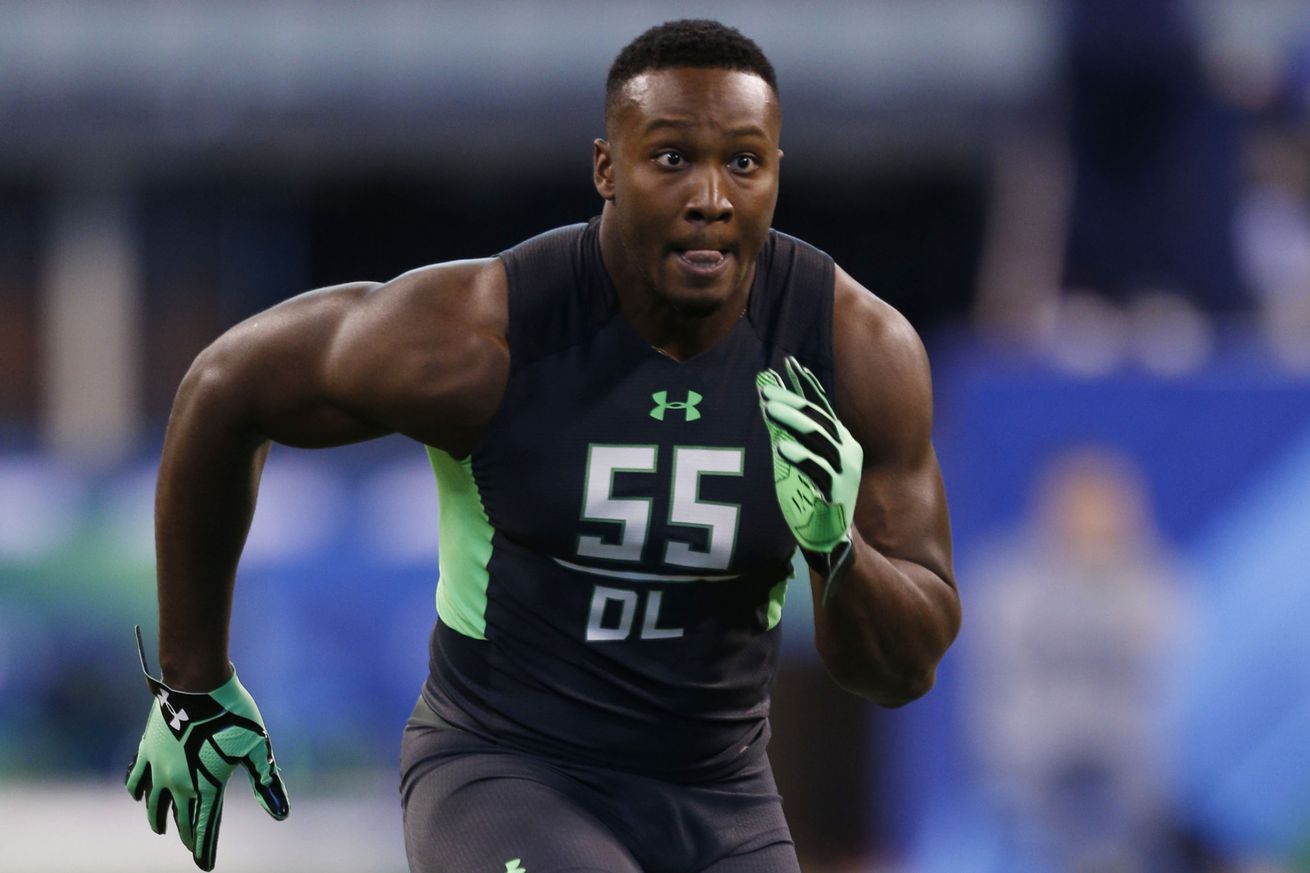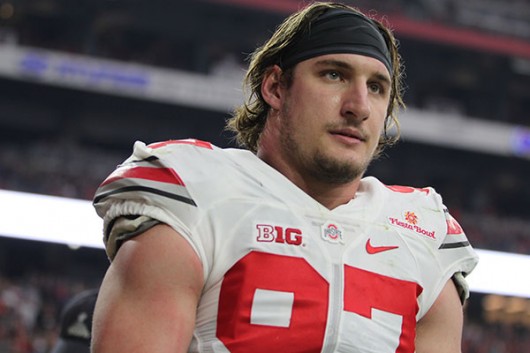Yesterday I made an appearance on ESPN 960 in Utah to discuss Bronson Kaufusi. You can hear the audio above. I’ll also be on KJR with Softy today at 5pm PST so if you get an opportunity check it out.
Plus — here’s a podcast with two days to go. Kenny and I will be recording another on Wednesday too:
Last week we linked to a mock draft by ESPN’s Louis Riddick which was interesting for two reasons:
1. It was different
2. It wasn’t totally absurd despite being different
It also presented a scenario where several potential Seahawks were still on the board.
Reggie Ragland, Kevin Dodd, Vernon Butler, Germain Ifedi, Jonathan Bullard, Derrick Henry and Chris Jones all visited the VMAC and were sitting there for the Seahawks at #26.
Mike Mayock published his top-100 yesterday and it continues on a similar theme. Look at the following prospects and where they’re ranked:
#26 Reggie Ragland
#28 Germain Ifedi
#29 Emmanuel Ogbah
#30 Kevin Dodd
#31 Vernon Butler
#32 Noah Spence
#36 Jason Spriggs
If Seattle’s board is anything like Mayock’s this group could be available to them.
Perhaps more interesting is the range Mayock had some other prospects ranked:
#57 Chris Jones
#58 Keanu Neal
#64 Derrick Henry
#65 Jonathan Bullard
#77 Bronson Kaufusi
#80 Shon Coleman
#92 Connor McGovern
Mayock is connected — and that perhaps gives his top 30-40 some genuine credence. I’m not sure he’s using total insider info though on a top-100. I would expect Keanu Neal, for example, to go a lot earlier than the late 50’s.
That said — there might be some useful info here. Are teams simply grading Jonathan Bullard as a second rounder? Could he be there at #56? Will Derrick Henry last until Seattle’s second rounder and could he be an option?
And perhaps more importantly — could we really see Shon Coleman, Connor McGovern, Joe Haeg and Joe Dahl available within range of Seattle’s two third round picks?
Imagine a scenario where the Seahawks came out of the draft with Noah Spence, Jonathan Bullard, Connor McGovern and Joe Haeg. Or any combination of the players listed above.
It wouldn’t be a total surprise if someone like Bullard lingered into round two. Especially after one scout described him as such:
“Is he a great player? No. Solid rotational player.”
This also reinforces why teams are really valuing the second and third round. Just looking at Mayock’s board you can see it’s stacked in that range. The Tennessee Titans played an absolute blinder in their trade with the Rams.
Jason La Canfora has really interesting things to say
So what are the Seahawks going to do per JLC? In a really detailed piece that is worth checking out, he had the following to say:
The Seattle Seahawks are not afraid to wheel and deal. GM John Schneider might be the best in the business and he loves this draft — especially deeper along. The Seahawks believe it’s the richest draft since 2010, and he is never averse to trading out of the first round when picking so low. If someone wants to jump up from the early-second round to here to get a quarterback, well, sources said other execs are well aware the Seahawks are open for business. They have a bunch of picks and wouldn’t mind having more.
It could be the Browns, Bills or Saints or any team that wants to get ahead of the Cardinals and Chiefs that could go QB late in the first round to get their guy, whether it be Lynch or Connor Cook or Christian Hackenberg.
Now, I will mention that the Seahawks believe their medical team and advanced sport science department give them a competitive edge (consider their work with Michael Bennett, for instance) so if a stud player slips for a medical reason and Schneider sees value there, that could be the pick. And they certainly have a need on the offensive line. All things being equal, however, this spot is ripe for a trade and there would be linemen on either side of the ball who Seattle would likely fancy in the top half of the second round.
I’m not sure what to make of the talk of a ‘stud player’ slipping. There aren’t many candidates — and they’re not going to take Jaylon Smith at #26.
Is this a Myles Jack thing? Or is it someone else?
The player in question could be Shaq Lawson. There’s been a lot of talk about a bad shoulder for Lawson impacting his stock. He actually has a nice athletic profile:
Height: 6-2 1/2
Weight: 269lbs
Length: 33 inch arms
40-yd: 4.70
10-yd: 1.64
Vertical: 33 inches
Broad: 10-0
Three cone: 7.16
Short shuttle: 4.21
At his size that short shuttle time is elite. His broad jump is highly explosive. His split is pretty good for his size and not far off the elite 1.5’s.
In some mocks Lawson is listed in the top-15 and in others he drops well down into the late first. Just keep him in mind based on what La Canfora is saying here.
Mayock lists him as the 13th best player in the draft.
Initially I linked these two sentences together:
If a stud player slips for a medical reason and Schneider sees value there, that could be the pick. And they certainly have a need on the offensive line.
I thought he was referring to an injured O-liner (aka Shon Coleman). On reflection I think it’s more a case of they’ll stay at #26 if:
a.) a stud player slips for a medical reason
b.) They really like an O-liner at that spot
So it looks increasingly like the Seahawks are going to move down unless there’s a major rush on O-liners and they get spooked into taking Germain Ifedi (for example) with their top pick. All the signs point to a trade down into the 30’s.
My prediction is when they finally start to take players off the board — they’ll be gunning for size, athleticism and impact.
When John Schneider talked about becoming the bully again — I think it’ll mean they want to get bigger and faster. They’ve kind of emphasised speed over size since 2013. This year I’d expect physical, big, tough and athletic to be the priority.
That’s evident from the list of names they’ve met with — Ifedi, Bullard, Butler, Jones, Henry, Dodd etc.
The exception could be if they see a truly excellent EDGE available (that could be Lawson or Noah Spence). Even then a hybrid DE-DT with size and rare mobility seems much more likely on defense.
How the ideal scenario could play out
I really don’t want to get anyone’s hopes up that Sheldon Rankins will fall to #26.
Daniel Jeremiah published a mock yesterday where that exact scenario happened. It’s worth noting that Jeremiah has consistently graded Rankins at about #26 on his big board. Contrast that to Mayock who has him at #11 overall.
Someone will undoubtedly take him before Seattle’s pick because he’s the most explosive defensive lineman in the draft. Here’s what would need to happen, however, for the ideal prospect to fall to the Seahawks:
1. New Orleans would need to take Paxton Lynch at #12
2. Miami and Oakland would need to pass on Darron Lee, pushing him to the Falcons
3. The Lions and Colts would need to be focused on their O-lines
4. The Bills would need to prioritise either a quarterback or an edge rusher
5. Scot McCloughan would need to be temporarily distracted or perhaps tied up and locked in a closet
6. Cincinnati would need to be totally zoned in on receivers and not put off by two going right in front of them to Houston and Minnesota
7. Pittsburgh would need to focus on their secondary
It’s asking an awful lot as you can see. You could argue stranger things have happened — but even this seems really far fetched.




